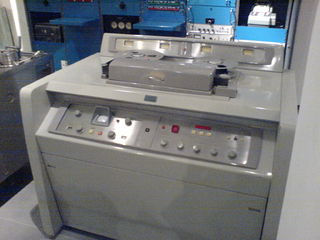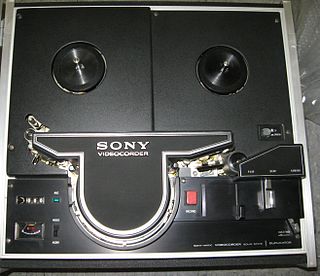
Phase Alternating Line (PAL) is a colour encoding system for analog television. It was one of three major analogue colour television standards, the others being NTSC and SECAM. In most countries it was broadcast at 625 lines, 50 fields per second, and associated with CCIR analogue broadcast television systems B, D, G, H, I or K. The articles on analog broadcast television systems further describe frame rates, image resolution, and audio modulation.

VHS is a standard for consumer-level analog video recording on tape cassettes, introduced in 1976 by the Victor Company of Japan (JVC). It was the dominant home video format throughout the tape media period in the late 1970s through the early 2000s.

Betamax is a consumer-level analog recording and cassette format of magnetic tape for video, commonly known as a video cassette recorder. It was developed by Sony and was released in Japan on May 10, 1975, followed by the US in November of the same year.

D-1 or 4:2:2 Component Digital is an SMPTE digital recording video standard, introduced in 1986 through efforts by SMPTE engineering committees. It started as a Sony and Bosch – BTS product and was the first major professional digital video format. SMPTE standardized the format within ITU-R 601, also known as Rec. 601, which was derived from SMPTE 125M and EBU 3246-E standards.
Betacam is a family of half-inch professional videocassette products developed by Sony in 1982. In colloquial use, Betacam singly is often used to refer to a Betacam camcorder, a Betacam tape, a Betacam video recorder or the format itself.

A video tape recorder (VTR) is a tape recorder designed to record and playback video and audio material from magnetic tape. The early VTRs were open-reel devices that record on individual reels of 2-inch-wide (5.08 cm) tape. They were used in television studios, serving as a replacement for motion picture film stock and making recording for television applications cheaper and quicker. Beginning in 1963, videotape machines made instant replay during televised sporting events possible. Improved formats, in which the tape was contained inside a videocassette, were introduced around 1969; the machines which play them are called videocassette recorders.

A professional video camera is a high-end device for creating electronic moving images. Originally developed for use in television studios or with outside broadcast trucks, they are now also used for music videos, direct-to-video movies, corporate and educational videos, wedding videos, among other uses. Since the 2000s, most professional video cameras are digital.

U-matic or 3⁄4-inch Type E Helical Scan or SMPTE E is an analogue recording videocassette format first shown by Sony in prototype in October 1969, and introduced to the market in September 1971. It was among the first video formats to contain the videotape inside a cassette, as opposed to the various reel-to-reel or open-reel formats of the time. The videotape is 3⁄4 in (19 mm) wide, so the format is often known as "three-quarter-inch" or simply "three-quarter", compared to open reel videotape formats in use, such as 1 in (25 mm) type C videotape and 2 in (51 mm) quadruplex videotape.

1-inch Type C Helical Scan or SMPTE C is a professional reel-to-reel analog recording helical scan videotape format co-developed and introduced by Ampex and Sony in 1976. It became the replacement in the professional video and broadcast television industries for the then-incumbent 2-inch quadruplex videotape open-reel format. Additionally, it replaced the unsuccessful type A format, also developed by Ampex, and primarily in mainland Europe, it supplemented the type B format, developed by the Fernseh division of Bosch.

1-inch Type B Helical Scan or SMPTE B is a reel-to-reel analog recording video tape format developed by the Bosch Fernseh division of Bosch in Germany in 1976. The magnetic tape format became the broadcasting standard in continental Europe, but adoption was limited in the United States and United Kingdom, where the Type C videotape format met with greater success.

2-inch quadruplex videotape was the first practical and commercially successful analog recording video tape format. It was developed and released for the broadcast television industry in 1956 by Ampex, an American company based in Redwood City, California. The first videotape recorder using this format was built the same year. This format revolutionized broadcast television operations and television production, since the only recording medium available to the TV industry until then was motion picture film.
International Video Corporation, or IVC, was a California company with large European operations that manufactured a number of models of middle to high-end video tape recorders, or VTRs, for industrial and professional use in the US, alongside a range of digital video Time Base Correctors and Special Effects units designed and manufactured in the UK. Their products were very popular in the industrial, scientific, research, medical, education, and institutional markets from the late 1960s through the 1980s.

Betamovie is the brand name for a range of consumer grade camcorders developed by Sony for the Betamax format. By "camcorder" is understood a single unit comprising a video camera and a video recorder.

IVC 2 inch Helical scan was a high-end broadcast quality helical scan analog recording VTR format developed by International Video Corporation (IVC), and introduced in 1975. Previously, IVC had made a number of 1 inch Helical VTRs. IVC saw a chance to make a VTR that would have the quality of the then-standard 2 inch Quadruplex videotape format but with the advantages of helical scan. They then developed a VTR using this technology, the IVC Model 9000.

Compact Video Cassette (CVC) was one of the first analog recording videocassette formats to use a tape smaller than its earlier predecessors of VHS and Betamax, and was developed by Funai Electronics of Japan for portable use. The first model of VCR for the format was the Model 212, introduced in 1980 by both Funai and Thomson SA as they had created a joint venture to manufacture and introduce the format to the home movie market. The system, which included the VCR and a hand held video camera, was very small and lightweight for its time.

EIAJ-1 was a standard for video tape recorders (VTRs) developed by the Electronic Industries Association of Japan with the cooperation and assistance of several Japanese electronics manufacturers in 1969. It was the first standardized format for industrial/non-broadcast VTRs using a helical scan system employing open reel tape. Previously, each manufacturer of machines in this market used a different proprietary format, with differing tape speeds, scanner drum diameters, bias frequencies, tracking head placement, and so on, although most used 1/2" wide tape. As a result, video tapes recorded on one make and/or model of VTR could only be interchanged with other machines using that specific format, hampering compatibility. For example, a reel of tape recorded on a Panasonic machine would not play on a Sony machine, and vice versa. The EIAJ-1 standard ended this incompatibility, giving those manufacturers a standardized format, interchangeable with almost all VTRs subsequently brought to market around that time. The format offered black-and-white video recording and playback on 1/2″ magnetic tape on a 7″ diameter open reel, with portable units using smaller 5″ diameter reels.
VK is a helical scan analog recording videocassette format developed by Akai in the late 1970s, that is capable of recording and playing back black & white video in either EIA and CCIR systems.
CV-2000 was one of the world's first home video tape recorders (VTR), introduced by Sony in August, 1965. The 'CV' in the model name stood for 'Consumer Video'. This was Sony's domestic format throughout the 1960s. It was the first fully transistorized VCR.
Electronovision was a process used by producer and entrepreneur H. William "Bill" Sargent, Jr. to produce a handful of motion pictures, theatrical plays, and specials in the 1960s and early 1970s using a high-resolution videotape process for production, later transferred to film via kinescope for theatrical release.
From 1963 to 1970, Ampex manufactured several models of VTR 2-inch helical VTRs, capable of recording and playing back analog black and white video. Recording employed non-segmented helical scanning, with one wrap of the tape around the video head drum being a little more than 180 degrees, using two video heads. One video drum rotation time was two fields of video. The units had two audio tracks recorded on the top edge of the tape, with a control track recorded on the tape's bottom edge. The 2-inch-wide video tape used was one mil thick. The VTRs were mostly used by industrial companies, educational institutions, and a few for in-flight entertainment.














